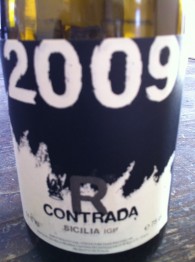What a pleasant day to visit the Cambria family, makers of Cottanera, on a sunny spring morning.
Etna was behaving itself though there was a thin cloud of steam emitting as one looked across the nerello mascalese vines towards the south.
This visit was hailed as a property taking the international approach-the philosophy focussed on international varietals and a more international style of winemaking.
Cottanera today is reversing its trend and philosophy, and I was there to investigate. We were in Castiglione di Sicilia.
This brand is current in Australia and is becoming well known.
The welcoming party was extensive-principal Vincenzo explained the wines, assisted by Enzo, Emanuele, Francesco and Mariangela.
I took to the Etnabianco immediately because the grape used is really going to be the white face of Etna in future-carricante. It just loves growing at this elevation and produces great results.
Etnabianco 2011 (88) 13%; DOC Etna is pale, not an aromatic or tropical wine, its making in stainless steel actually preserves its terroir; its all about the taste, the minerally, stony notes, long and lean, mouth salivating and delicacy to boot.
The international winemaking here is all about the cool ferment-it preserves fruit and the delicate notes which the grape possesses.Curiously there is is ten percent catarratto included (the western Sicily white used in Marsala) which must be an experiment to see how it performs on Etna. Good so far.
The more international style white is Barbazzale Bianco 2011 (88) 12.5%; IGT which blends a terrific local white-inzolia with Rhone-origin viognier, and gives it a big slap of skin components.
The word barbazzale means golden beard for those curious about the naming.
This looks like work in progress as both varieties have a tendency to taste chewy. This is a step up in body over the loveable, racy, carricante.
The Barbazzale Rosso 2011 (89) 13% DOC Etna is back to traditional Etna red grapes-nerello mascalese and nerello capuccio housed in some new French oak which was evident; these grapes have a lovely texture and softness, even at entry level wines.
The internationalisation of Etna’s prima red grape, nerello mascalese goes one stage further when blended with merlot and shiraz at 15 percent.
That makes Fatagione 2009 (93) 13.5% IGT; a hybrid of flavours which captures the silkiness of nerello with the bigger and fleshier merlot and shiraz; it works well in a new French oak barrel for a year.
The key to this style appears to not being heavy handed with the international pair-keep them in small proportions so the long fleshiness of nerello is not interrupted. Other vintages 2008 (90) and 2010 (92).
Cottonera make a big monster chewy Merlot called Grammonte 2008 (87) 14.5% IGT; other vintages 2007 (90) and 2009 (88). And a curio variety, a savoury Mondeuse called L’Ardenza 2007 (90) 13.5% IGT.
Finally I had to deal with how cabernet sauvignon grows on this mountainside. Cabernet is a very important grape, and the better ones around the world become the domain of collectors. It’s a variety with a great capacity to age and also excite.
This was my first Sicilian cabernet. It did not come across as a cool climate style (Yarra Valley) so I had to make warmer regions-McLaren Vale comparisons.
Nume 2007 (90) 14.5% IGT is a big chunky style of rich and ripe cabernet, has fifteen percent franc, ample layers of ripe cassis and minty fruit, powdery tannins and plenty to satisfy hearty drinkers. Other vintages 2006 (90) and 2008 (91).
The verdict: international versus indigeneous varieties; both types are well-made wines, people chasing honest and original wine will ask for carricante and nerello; new drinkers will just buy international if they are allowed to do so.
A true test of the winemaking is in the straddle of international varieties with local so that the wines produced become the unique personality of the property, local terroir and therefore the lasting and distinctive part of branding.
Etna has special values-it’s a great destination.
















 Top Italian reds: are the Tuscans prevailing or is the pre-eminence of Piedmontese nebbiolo be set to prevail?
Top Italian reds: are the Tuscans prevailing or is the pre-eminence of Piedmontese nebbiolo be set to prevail?







